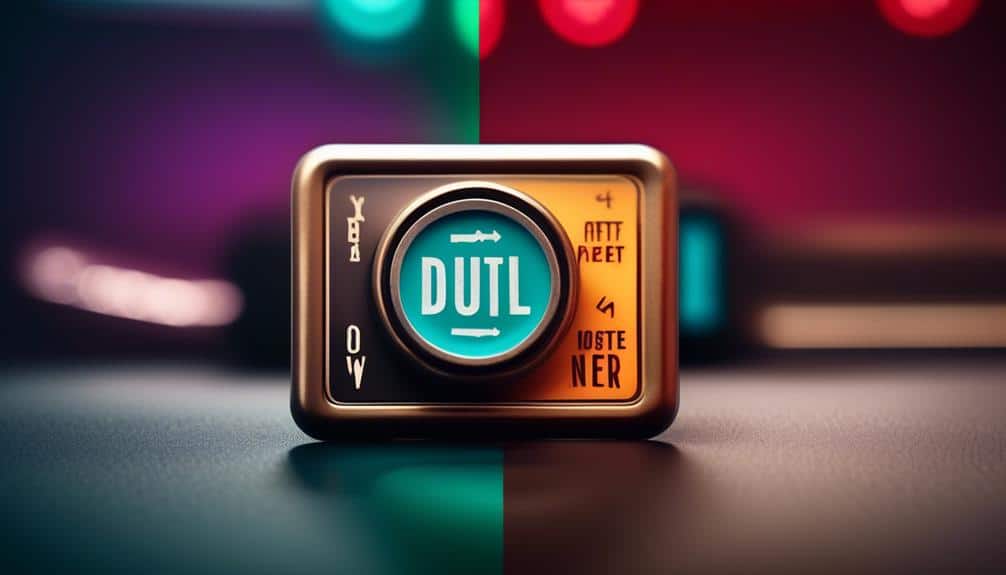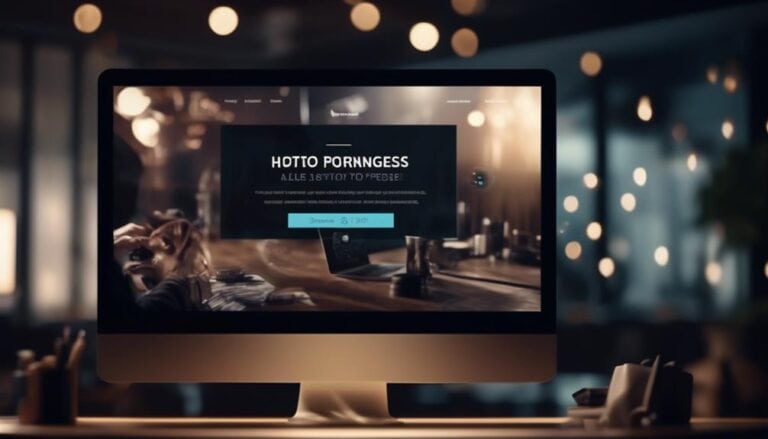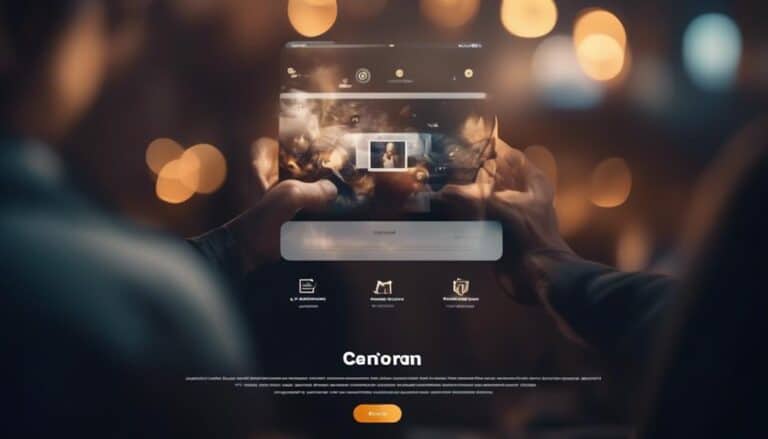From Bland to Compelling: Transforming Your Calls-to-Action for Better Engagement
When it comes to enhancing the effectiveness of your calls-to-action, there may be room for improvement in how you engage with your audience. By refining the way you present your CTAs, you could potentially see a significant boost in user interaction and conversions.
It's not just about the words you use but also the strategies employed to capture attention and drive action. By exploring key elements that transform lackluster CTAs into compelling prompts, you could unlock a whole new level of engagement that resonates with your target audience.
Key Takeaways
- Be clear and direct in crafting CTAs
- Utilize persuasive language to captivate and connect with the audience
- Design eye-catching CTA buttons using color psychology and visual appeal
- Use data-driven optimization techniques to tailor CTAs effectively
Understanding the Importance of CTAs

Understanding the power of CTAs in your marketing strategy can be the difference between blending in with the crowd and standing out in a sea of competitors. By delving into CTA optimization strategies, you unlock the key to captivating user psychology and driving action. Your CTAs aren't just buttons or links; they're gateways to heightened CTA conversion rates and enriched customer engagement.
Imagine your CTA as a trailhead marker in a dense forest. It guides your audience on a journey, signaling where to turn next and what wonders await. Just like hikers trust these markers to lead them safely through unknown terrain, your audience relies on CTAs to navigate your digital landscape.
Through a deep understanding of user psychology, you can tailor your CTAs to resonate with your audience on a subconscious level. Every word, color, and placement matters in the quest for optimal CTA performance. Stay tuned as we uncover more secrets to transforming your CTAs into powerful tools of engagement and conversion.
Crafting Concise and Actionable Text
Crafting compelling and succinct text in your calls-to-action is the cornerstone of driving user engagement and action. When it comes to engaging copywriting, every word counts. Here are some tips to help you craft concise and actionable text that grabs your audience's attention:
- Be Clear and Direct:
Use language that's straight to the point and leaves no room for ambiguity.
- Create a Sense of Urgency:
Incorporate actionable language that prompts immediate action from your audience.
Engaging copy isn't just about being creative; it's about motivating your audience to take the desired action. By using actionable language and keeping your text concise, you can compel your users to engage with your calls-to-action effectively. Remember, in the world of digital marketing, brevity is key.
Leveraging Persuasive Language Techniques

By infusing your calls-to-action with persuasive language techniques, you can captivate your audience and drive them towards taking meaningful actions. Persuasion techniques are powerful tools that can help you connect with your audience on a deeper level, inspiring them to act upon your message. Language strategies play a crucial role in shaping how your audience perceives and responds to your calls-to-action.
Imagine using vivid and descriptive language that paints a compelling picture in the minds of your audience. By incorporating storytelling elements and emotional appeal into your calls-to-action, you can create a sense of urgency and excitement that motivates people to engage with your content.
Moreover, leveraging the principle of social proof and scarcity in your language can further enhance the persuasiveness of your calls-to-action. By highlighting the benefits of taking immediate action and emphasizing the limited availability of your offer, you can create a sense of exclusivity and drive conversions.
Innovate your language strategies today to transform your calls-to-action into irresistible invitations that compel your audience to act decisively.
Designing Eye-Catching CTA Buttons
Elevate the impact of your persuasive language techniques by translating them into visually captivating CTA buttons that beckon your audience to click and engage.
When it comes to designing eye-catching CTA buttons, two key elements play a significant role in capturing your audience's attention and driving them to take action:
- Color Psychology:
- Understand the Psychology: Colors evoke emotions and influence behavior. Choose colors wisely based on the desired action. For example, red can create a sense of urgency, while blue conveys trust and reliability.
- Contrast is Key: Use contrasting colors for your CTA buttons to make them stand out. The contrast between the button color and the background can draw the eye and guide the user towards the desired action.
- Button Size:
- Find the Right Balance: Ensure your CTA button is large enough to be easily clickable on various devices, but not so large that it overwhelms the page.
- Prioritize Mobile: With the increasing use of mobile devices, make sure your CTA buttons are big enough to tap comfortably on a smartphone screen.
Utilizing Strategic Placement on Your Website

When you strategically place your calls-to-action on your website, you guide your visitors seamlessly towards taking action.
By optimizing the placement of your CTAs, you can enhance the overall user experience and increase the likelihood of conversion.
Let's explore how strategic CTA placement can transform your website engagement and drive better results.
Optimal CTA Placement
Wondering where to strategically place your Calls-to-Action for maximum impact on your website's engagement? The placement of your CTAs can significantly influence conversion rates and user behavior. Here's a guide to help you make the most out of your CTA positioning:
- Above the Fold:
- Grab user attention instantly.
- Ideal for promoting time-sensitive offers or critical actions.
- At the End of Engaging Content:
- Capture users who are already interested.
- Encourages a seamless transition to the next step.
Enhancing User Experience
To enhance user experience on your website, strategically placing your Calls-to-Action can guide visitors towards desired actions more effectively. By understanding user feedback and incorporating interactive elements, you can create a seamless journey for your audience. Imagine a scenario where a visitor lands on your homepage and is immediately drawn to a visually appealing CTA button that offers a personalized experience. This simple yet strategic placement not only captures their attention but also encourages interaction. Utilizing user feedback to fine-tune these placements ensures that your CTAs are not only visible but also tailored to meet the needs and expectations of your visitors. Interactive elements further enhance engagement, making the user experience dynamic and engaging.
| User Feedback | Interactive Elements | Strategic Placement |
|---|---|---|
| Helps improve website experience based on user insights | Adds dynamic features that encourage user interaction | Guides users towards desired actions effectively |
A/B Testing for Optimal Performance
A/B Testing for Optimal Performance
Enhance your call-to-action performance through A/B testing and unlock the potential for optimal engagement with your audience. A/B testing is a powerful tool that allows you to compare two versions of a call-to-action to see which one performs better based on specific performance metrics and conversion rates.
- Performance Metrics: A/B testing enables you to track and analyze various performance metrics such as click-through rates, bounce rates, and conversion rates. By understanding these metrics, you can make data-driven decisions to optimize your call-to-action for better results.
- Increased click-through rates indicate that your call-to-action is compelling and resonating with your audience.
- Lower bounce rates suggest that visitors are engaging with your call-to-action and finding value in the content presented.
Incorporating Urgency and Scarcity Elements

Amidst the sea of digital content, infusing your calls-to-action with elements of urgency and scarcity can captivate your audience's attention and drive immediate action. Creating scarcity in your offers can evoke a sense of exclusivity and desirability, prompting users to act swiftly to secure the limited opportunity. Urgency tactics, such as countdown timers or limited-time discounts, can create a fear of missing out, compelling users to engage promptly.
Enhancing engagement through scarcity involves strategically positioning your call-to-action as a must-have rather than a nice-to-have. By emphasizing the limited availability of your product or service, you create a sense of urgency that motivates users to take action promptly. Implementing phrases like 'Act Now' or 'Limited Stock Available' can instill a sense of urgency in your audience, prompting them to prioritize your offer over others.
Personalizing CTAs for Targeted Audiences
Craft a compelling call-to-action by tailoring it to resonate with the specific needs and preferences of your targeted audience. When it comes to personalizing CTAs for targeted audiences, you need to delve deep into personalization strategies and targeting tactics.
Here's how you can effectively tailor your CTAs to drive engagement:
- Audience Segmentation: Divide your audience into specific segments based on demographics, behavior, or preferences. This allows you to create CTAs that speak directly to each segment's unique characteristics.
- By understanding the different segments within your audience, you can craft CTAs that address their specific pain points or desires.
- Tailored Messaging: Once you have segmented your audience, customize the messaging of your CTAs to align with each segment's interests and motivations. This level of personalization can significantly increase the likelihood of conversion and engagement, as it shows your audience that you understand their individual needs and are providing solutions tailored to them.
Enhancing Visual Appeal With Graphics

Enhance the visual appeal of your calls-to-action by incorporating captivating graphics that draw in your audience and entice them to take action. Graphic design plays a crucial role in making your CTAs stand out and grab attention. Imagine a scenario where your CTA is a plain text button that says "Click Here." Now, picture another CTA with a visually stunning graphic that complements the message, such as a bold icon or an eye-catching illustration. Which one would you be more inclined to click on? The answer is clear – the visually appealing one.
To illustrate the impact of graphics on CTAs, consider the following table that showcases the difference between a text-only CTA and one enhanced with graphic design:
| Text-Only CTA | CTA with Graphic Design |
|---|---|
| Click Here | ![Eye-catching Icon] |
| Learn More | ![Engaging Illustration] |
Analyzing Data and Iterating for Success
Alright, picture this – you've put in the effort to revamp your calls-to-action, but how do you know if they're hitting the mark?
That's where data analysis swoops in to save the day. By analyzing the numbers and continuously testing different strategies, you can fine-tune your approach for maximum engagement.
Data-Driven Improvements
To achieve better engagement with your calls-to-action, start by diving into your data analytics to uncover insights that can drive iterative improvements for success. When delving into data analysis, consider these key points:
- Understanding User Behavior: Analyze user interaction patterns to tailor your calls-to-action effectively.
- Utilize heatmaps and session recordings to identify areas of interest and friction points.
- Conversion Optimization: Implement A/B testing to refine your CTAs continuously.
- Experiment with different wording, colors, placements, and sizes to maximize conversion rates.
Iterative Testing Strategies
With each round of iterative testing, your data-driven insights pave the way for enhanced engagement and continued success in your calls-to-action strategy. By analyzing user behavior and conversion rates meticulously, you unlock the secrets to optimizing your CTAs. Imagine the power of refining your CTAs based on concrete data, ensuring that every click counts towards your ultimate goal. Iterative testing allows you to experiment, learn, and adapt swiftly, keeping your strategy dynamic and effective. Embrace the iterative process as a journey of discovery, where each test brings you closer to understanding what truly resonates with your audience. Take charge of your CTAs, harness the potential of iterative testing, and watch your engagement soar to new heights.
| User Behavior Analysis | Conversion Rate Optimization |
|---|---|
| Study how users interact with CTAs | Test different CTA variations |
| Identify patterns and preferences | Analyze impact on conversion rates |
| Refine CTAs based on user insights | Implement changes for improved results |
Frequently Asked Questions
How Can I Ensure That My CTAs Are Not Overwhelming or Pushy for My Audience?
You want your CTAs to be clear and inviting, not overwhelming. Keep it real, avoid being pushy. Show authenticity, offer value, and make it easy for your audience to engage. Balance is key.
Are There Any Specific Language Techniques That Should Be Avoided When Crafting Ctas?
When crafting CTAs, avoid manipulation by being honest in your language. Skip over-the-top promises or excessive urgency. Instead, focus on clarity and value. Your audience appreciates authenticity and straightforwardness, so keep it real!
What Are Some Common Mistakes to Avoid When Designing CTA Buttons?
When designing CTA buttons, avoid making them too small or blending into the background. Use contrasting colors for better visibility. Remember, button design and color psychology play crucial roles in catching your audience's attention and driving engagement.
How Can I Effectively Incorporate Urgency and Scarcity Elements Without Coming Across as Dishonest or Manipulative?
To weave ethical persuasion into your calls-to-action, infuse genuine urgency and scarcity elements. By authentically highlighting limited availability or time-bound offers, you captivate attention without resorting to deceitful tactics, fostering trust and driving action.
What Are Some Best Practices for Analyzing CTA Performance Data and Making Informed Decisions for Improvement?
Want to boost engagement? Dive into A/B testing analysis to optimize your CTAs. Track conversion rates for data-driven decisions. By fine-tuning through data, you'll transform your CTAs from good to great, capturing attention and driving action.
Conclusion
Congratulations on transforming your bland CTAs into compelling ones!
By understanding the importance of CTAs, crafting concise and actionable text, leveraging persuasive language techniques, and designing eye-catching buttons, you have successfully increased engagement on your website.
Utilizing strategic placement, incorporating urgency and scarcity, personalizing for targeted audiences, enhancing with graphics, and analyzing data for iteration are also key elements in this success.
Keep up the great work and continue to fine-tune your CTAs for even better results!








